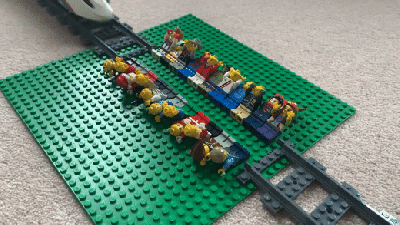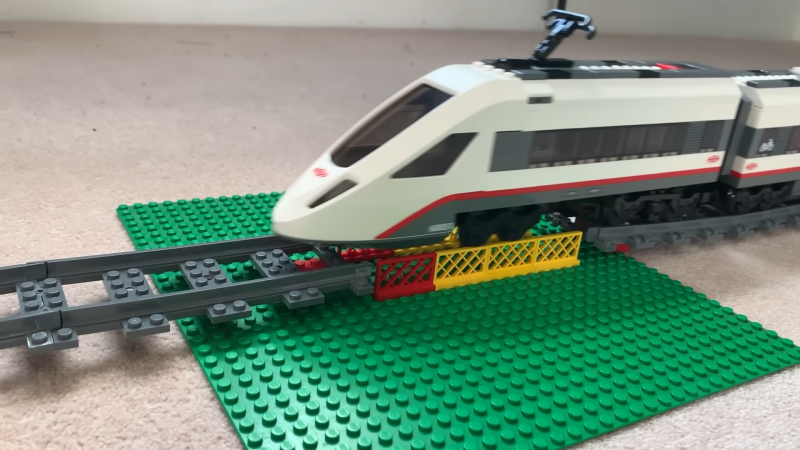LEGO trains are fun to play with, but as with any model train, you so seldom have enough track to fulfill your greatest desires. YouTuber [brick_on_the_tracks] has come up with some creative ideas of his own to make track compatible with Lego trains using other techniques.

The most straightforward is to use the LEGO fence piece, first released in 1967. They can be laid in two rows, four studs apart, and they’ll serve as perfectly functional train track. It’s a 100% legal building technique as per the official LEGO rules, too. Official track pieces can be linked up by placing them on a 1-stud-high booster. [brick_on_the_tracks] argues that it’s up to nine times cheaper than using official track, but it depends on how you’re building your layout, and you need to take into account the need for a base plate.
On the sillier side of things, it’s actually possible to use mini-figures as track, too. Again, it’s a 100% legal technique, though the trains don’t run as smoothly compared to the fence track. It’s very amusing, though, and could be a fun addition to a build you’re taking to a local LEGO convention.
If you’re really strapped for cash though, you can go as far as using cardboard. It’s not legal in the LEGO world, and it’s pretty basic, but you could literally make up a layout using nothing but a craft knife and pizza boxes. We’ve actually featured other LEGO train hacks before, like this neat automatic decoupler design.

















Given the rails are pure plastic it’s also possible to 3D print them if desired. It’s something I’ve wanted to do for a while – actually a large part of why I even have a 3D printer.
The tolerances on a cheap printer like I’ve got aren’t great so they won’t be super compatible with real lego, but if your only objective is to lay track end-to-end then it’s not a major issue.
https://www.thingiverse.com/thing:593222
Seems to be possible, I see various prints of lego track.
My lego train has electrified rails, which is completely the same as the current rails, except it is electrified. So none of the new tracks is really compatible with my train :(
You could probably get HO, N, or similar sized tracks, remove the rails from them then print lego compatible sleepers
The flange on a LEGO train wheel is very deep, it would have to be O gauge, maybe even bigger for the rails to be tall enough. Think you are probably better off getting laser cut steel sheet with fold over tabs to mate it to the 3d printed sleepers than trying to salvage rails. I expect you would get a better for LEGO and cheaper result.
Put a battery or supercap in the train to bridge the times when it’s not on the electrified rail?
Foil tape is the common solution, even just for making current production track work with the 9v system.
Even something basic like a basic ender v2 can spit out perfectly compatible lego pieces. Resin printers do a fantastic job. It might take a bit of tweaking to get the shape just right, but it doesn’t take long, and you can get some really great custom pieces.
I have printed entire sections of track some models are better than others out there but they work really well
I 3d printed a crossing and it required lots of extra dremel work to get it to connect to other rail pieces.
In my experience 3d printing LEGO compatible things is a disaster. Maybe because I suck at it.
We wanted to print LEGO compatible marble run pieces (sort of smaller version of Hubelino). On filament printer using PLA it was not very precise and did not line up well. So we tried on resin printer, it has been a bit better but resin is more stiff and brittle and didnt stiick well either. Maybe ABS would be better than PLA or resin because it seems more flexible.
Anyway, LEGO pieces are made with very tight tolerances, this is why they are so good. Just try some compatible pieces like MEGA CONSTRUX and there is huge difference.
slow news day
Yep, this time I really agree: filler news…
Better to have slow news than fake news to fill the time.
following that logic you can always find a “lower point” ;)
Right, slow news day here on hackaday, where I go in my three 45 second long cigarette-biobreak-and-feeding-at-once breaks each day to catch up on the important news out there, and for obvious reason **only** on the important news, before going back to saving Gotham.
jeeeez.
Now I’m intrigued as to who in the Lego world defines what’s “legal” and “illegal” and what the process is?
There is a list somewhere, I believe the definitions were entirely created by Lego for their official set designers.
Though I know the rules now at least call techniques that Lego themselves have used in older sets illegal – the one that jumps to mind is none of the thin plate bricks side on between the studs, which has been used for tail plane and general SNOT for about as long as there have been those plate parts in official sets until some time around 2000 if memory serves when it became forbidden.
Wait, that’s not allowed anymore? it’s been quite widely used…
As I understood, in theory, it bends the part with the studs. If you do a long row of this on a long plate, you can see the plate being bend.
As by my understanding, “illegal” lego techniques are the ones that potentially could damage the pieces. But nobody is going to call the lego police on you.
I just learned this this past year. A legal technique is one that conforms to the engineering design of the various bricks. It’s a fascinating subarea of Lego building. Here is the video where I learned the specifics:
https://www.youtube.com/watch?v=jWtZUzkvQ2E&t=1s
Thanks for the link.
LEGO publishes rules they themselves violated. In my LEGO world, if it fits and stays together to accomplish the job, it goes. My LEGO sets don’t come with a published set of rules. I build LEGO engines that work with vacuum or pressurized air with valves, pistons, etc. so I’m sure there is something inherently illegal in there somewhere. Meh…
I’m sure they have rules against using MegaBlox or others.
I will let you know if Good/Bad Cop shows up at my door.
Just don’t build a LEGO Demon Dome!
The minifig track puts a whole new spin on the trolley problem…
Representing an older generation, I am waiting for HaD to show how to use Lincoln Logs to make a clock. Or a carry handle for a Lego box.
Ah yes, the Lego solution to “The Trolley Problem” … just run over their feet.
LOL!